A New Method for Solid Acid Catalyst Evaluation for Cellulose Hydrolysis
Abstract
:1. Introduction
2. Materials and Methods
2.1. Materials
2.2. Catalysts Preparation
2.2.1. Sulfonated Humins (SH)
2.2.2. Sulfonated Activated Carbon (SAC)
2.2.3. Sulfated Zirconia (SZ)
2.2.4. HZSM-5
2.2.5. CMP-SO3H-0.3
2.3. Catalyst Wash
2.4. Solid-State Titration
2.5. Hydrothermal Treatment for Supernatant Generation
2.6. Cellulose Hydrolysis
2.7. Hydrolysate Analysis
2.8. Ion Analysis
2.9. Kinetic Modeling
2.10. Interactions between Solid Acid Catalyst and Soluble Substrates
2.11. Solid-State Nuclear Magnetic Resonance
3. Results and Discussion
3.1. Single-Point Measurements of Solid Acid and Supernatant Cellulose Hydrolysis Activity
3.2. Evaluation of False Negatives
3.3. False Positives Arising from Catalyst–Reactant Interactions
3.4. Recommended Protocol
4. Conclusions
Supplementary Materials
Author Contributions
Funding
Data Availability Statement
Conflicts of Interest
References
- Klemm, D.; Heublein, B.; Fink, H.-P.; Bohn, A. Cellulose: Fascinating Biopolymer and Sustainable Raw Material. Angew. Chem. Int. Ed. 2005, 44, 3358–3393. [Google Scholar] [CrossRef]
- Lynd, L. The grand challenge of cellulosic biofuels. Nat. Biotechnol. 2017, 35, 912–915. [Google Scholar] [CrossRef] [PubMed] [Green Version]
- Isikgor, F.H.; Becer, C.R. Lignocellulosic biomass: A sustainable platform for the production of bio-based chemicals and polymers. Polym. Chem. 2015, 6, 4497–4559. [Google Scholar] [CrossRef] [Green Version]
- Tyufekchiev, M.; Kolodziejczak, A.; Duan, P.; Foston, M.; Schmidt-Rohr, K.; Timko, M.T. Reaction engineering implications of cellulose crystallinity and water-promoted recrystallization. Green Chem. 2019, 21, 5541–5555. [Google Scholar] [CrossRef]
- Endo, T.; Aung, E.M.; Fujii, S.; Hosomi, S.; Kimizu, M.; Ninomiya, K.; Takahashi, K. Investigation of accessibility and reactivity of cellulose pretreated by ionic liquid at high loading. Carbohydr. Polym. 2017, 176, 365–373. [Google Scholar] [CrossRef] [PubMed]
- Zhao, H.; Jones, C.L.; Baker, G.; Xia, S.; Olubajo, O.; Person, V.N. Regenerating cellulose from ionic liquids for an accelerated enzymatic hydrolysis. J. Biotechnol. 2009, 139, 47–54. [Google Scholar] [CrossRef] [PubMed]
- Chundawat, S.P.S.; Bellesia, G.; Uppugundla, N.; Sousa, L.D.C.; Gao, D.; Cheh, A.M.; Agarwal, U.P.; Bianchetti, C.M.; Phillips, J.G.N.; Langan, P.; et al. Restructuring the Crystalline Cellulose Hydrogen Bond Network Enhances Its Depolymerization Rate. J. Am. Chem. Soc. 2011, 133, 11163–11174. [Google Scholar] [CrossRef]
- Zhang, Q.; Benoit, M.; Vigier, K.D.O.; Barrault, J.; Jégou, G.; Philippe, M.; Jérôme, F. Pretreatment of microcrystalline cellulose by ultrasounds: Effect of particle size in the heterogeneously-catalyzed hydrolysis of cellulose to glucose. Green Chem. 2013, 15, 963–969. [Google Scholar] [CrossRef]
- Wu, K.; Feng, G.; Liu, Y.; Liu, C.; Zhang, X.; Liu, S.; Liang, B.; Lu, H. Enhanced hydrolysis of mechanically pretreated cellulose in water/CO2 system. Bioresour. Technol. 2018, 261, 28–35. [Google Scholar] [CrossRef]
- Tao, L.; Schell, D.; Davis, R.; Tan, E.; Elander, R.; Bratis, A. NREL 2012 Achievement of Ethanol Cost Targets: Biochemical Ethanol Fermentation via Dilute-Acid Pretreatment and Enzymatic Hydrolysis of Corn Stover; National Renewable Energy Lab. (NREL): Golden, CO, USA, 2014. [Google Scholar]
- Yin, S.; Pan, Y.; Tan, Z. Hydrothermal Conversion of Cellulose to 5-Hydroxymethyl Furfural. Int. J. Green Energy 2011, 8, 234–247. [Google Scholar] [CrossRef]
- Zhu, Y.; Biddy, M.J.; Jones, S.B.; Elliott, D.; Schmidt, A.J. Techno-economic analysis of liquid fuel production from woody biomass via hydrothermal liquefaction (HTL) and upgrading. Appl. Energy 2014, 129, 384–394. [Google Scholar] [CrossRef]
- Möller, M.; Harnisch, F.; Schröder, U. Hydrothermal liquefaction of cellulose in subcritical water—the role of crystallinity on the cellulose reactivity. RSC Adv. 2013, 3, 11035–11044. [Google Scholar] [CrossRef]
- Questell-Santiago, Y.M.; Zambrano-Varela, R.; Amiri, M.T.; Luterbacher, J.S. Carbohydrate stabilization extends the kinetic limits of chemical polysaccharide depolymerization. Nat. Chem. 2018, 10, 1222–1228. [Google Scholar] [CrossRef] [PubMed]
- Cabiac, A.; Guillon, E.; Chambon, F.; Pinel, C.; Rataboul, F.; Essayem, N. Cellulose reactivity and glycosidic bond cleavage in aqueous phase by catalytic and non catalytic transformations. Appl. Catal. A Gen. 2011, 402, 1–10. [Google Scholar] [CrossRef]
- Negahdar, L.; Delidovich, I.; Palkovits, R. Aqueous-phase hydrolysis of cellulose and hemicelluloses over molecular acidic catalysts: Insights into the kinetics and reaction mechanism. Appl. Catal. B Environ. 2016, 184, 285–298. [Google Scholar] [CrossRef]
- Pala, H.; Mota, M.; Gama, F.M. Enzymatic depolymerisation of cellulose. Carbohydr. Polym. 2007, 68, 101–108. [Google Scholar] [CrossRef] [Green Version]
- Nill, J.; Karuna, N.; Jeoh, T. The impact of kinetic parameters on cellulose hydrolysis rates. Process. Biochem. 2018, 74, 108–117. [Google Scholar] [CrossRef]
- Hall, M.; Bansal, P.; Lee, J.H.; Realff, M.J.; Bommarius, A.S. Cellulose crystallinity—A key predictor of the enzymatic hydrolysis rate. FEBS J. 2010, 277, 1571–1582. [Google Scholar] [CrossRef]
- He, J.; Liu, M.; Huang, K.; Walker, T.W.; Maravelias, C.T.; Dumesic, J.A.; Huber, G.W. Production of levoglucosenone and 5-hydroxymethylfurfural from cellulose in polar aprotic solvent–water mixtures. Green Chem. 2017, 19, 3642–3653. [Google Scholar] [CrossRef]
- Ghosh, A.; Brown, R.C.; Bai, X. Production of solubilized carbohydrate from cellulose using non-catalytic, supercritical depolymerization in polar aprotic solvents. Green Chem. 2015, 18, 1023–1031. [Google Scholar] [CrossRef]
- Lynd, L.R.; Liang, X.; Biddy, M.J.; Allee, A.; Cai, H.; Foust, T.; Himmel, M.E.; Laser, M.S.; Wang, M.; Wyman, C.E. Cellulosic ethanol: Status and innovation. Curr. Opin. Biotechnol. 2017, 45, 202–211. [Google Scholar] [CrossRef] [Green Version]
- Pingali, S.V.; Urban, V.S.; Heller, W.T.; McGaughey, J.; O’Neill, H.; Foston, M.B.; Li, H.; Wyman, C.E.; Myles, D.A.; Langan, P.; et al. Understanding Multiscale Structural Changes During Dilute Acid Pretreatment of Switchgrass and Poplar. ACS Sustain. Chem. Eng. 2016, 5, 426–435. [Google Scholar] [CrossRef]
- Pu, Y.; Hu, F.; Huang, F.; Davison, B.H.; Ragauskas, A.J. Assessing the molecular structure basis for biomass recalcitrance during dilute acid and hydrothermal pretreatments. Biotechnol. Biofuels 2013, 6, 15. [Google Scholar] [CrossRef] [PubMed] [Green Version]
- Foston, M.; Ragauskas, A.J. Changes in lignocellulosic supramolecular and ultrastructure during dilute acid pretreatment of Populus and switchgrass. Biomass-Bioenergy 2010, 34, 1885–1895. [Google Scholar] [CrossRef]
- Yang, B.; Dai, Z.; Ding, S.-Y.; Wyman, C.E. Enzymatic hydrolysis of cellulosic biomass. Biofuels 2011, 2, 421–449. [Google Scholar] [CrossRef] [Green Version]
- Huang, Y.-B.; Fu, Y. Hydrolysis of cellulose to glucose by solid acid catalysts. Green Chem. 2013, 15, 1095–1111. [Google Scholar] [CrossRef]
- Onda, A.; Ochi, T.; Yanagisawa, K. Selective hydrolysis of cellulose into glucose over solid acid catalysts. Green Chem. 2008, 10, 1033–1037. [Google Scholar] [CrossRef]
- Tarabanko, N.; Tarabanko, V.E.; Kukhtetskiy, S.V.; Taran, O. Electrical Double Layer as a Model of Interaction between Cellulose and Solid Acid Catalysts of Hydrolysis. ChemPhysChem 2019, 20, 706–718. [Google Scholar] [CrossRef] [Green Version]
- Dumesic, J.A.; Huber, G.W.; Boudart, M. Principles of Heterogeneous Catalysis. In Handbook of Heterogeneous Catalysis; Wiley: Hoboken, NJ, USA, 2008. [Google Scholar]
- Shuai, L.; Pan, X. Hydrolysis of cellulose by cellulase-mimetic solid catalyst. Energy Environ. Sci. 2012, 5, 6889–6894. [Google Scholar] [CrossRef]
- Yuan, S.; Li, T.; Wang, Y.; Cai, B.; Wen, X.; Shen, S.; Peng, X.; Li, Y. Double-adsorption functional carbon based solid acids derived from copyrolysis of PVC and PE for cellulose hydrolysis. Fuel 2018, 237, 895–902. [Google Scholar] [CrossRef]
- Foo, G.S.; Sievers, C. Synergistic Effect between Defect Sites and Functional Groups on the Hydrolysis of Cellulose over Activated Carbon. ChemSusChem 2014, 8, 534–543. [Google Scholar] [CrossRef] [PubMed]
- Hu, L.; Li, Z.; Wu, Z.; Lin, L.; Zhou, S. Catalytic hydrolysis of microcrystalline and rice straw-derived cellulose over a chlorine-doped magnetic carbonaceous solid acid. Ind. Crop. Prod. 2016, 84, 408–417. [Google Scholar] [CrossRef]
- Zuo, Y.; Zhang, Y.; Fu, Y. Catalytic Conversion of Cellulose into Levulinic Acid by a Sulfonated Chloromethyl Polystyrene Solid Acid Catalyst. ChemCatChem 2014, 6, 753–757. [Google Scholar] [CrossRef]
- Qian, X.; Lei, J.; Wickramasinghe, S.R. Novel polymeric solid acid catalysts for cellulose hydrolysis. RSC Adv. 2013, 3, 24280–24287. [Google Scholar] [CrossRef]
- Yang, Q.; Pan, X. Synthesis and Application of Bifunctional Porous Polymers Bearing Chloride and Sulfonic Acid as Cellulase-Mimetic Solid Acids for Cellulose Hydrolysis. BioEnergy Res. 2015, 9, 578–586. [Google Scholar] [CrossRef]
- Bornscheuer, U.; Buchholz, K.; Seibel, J. Enzymatic Degradation of (Ligno)cellulose. Angew. Chem. Int. Ed. 2014, 53, 10876–10893. [Google Scholar] [CrossRef] [PubMed]
- Gazit, O.M.; Katz, A. Understanding the Role of Defect Sites in Glucan Hydrolysis on Surfaces. J. Am. Chem. Soc. 2013, 135, 4398–4402. [Google Scholar] [CrossRef]
- Tyufekchiev, M.V.; Duan, P.; Schmidt-Rohr, K.; Granados-Focil, S.; Timko, M.T.; Emmert, M.H. Cellulase-Inspired Solid Acids for Cellulose Hydrolysis: Structural Explanations for High Catalytic Activity. ACS Catal. 2018, 8, 1464–1468. [Google Scholar] [CrossRef]
- Scholz, D.F.; Kröcher, O.; Vogel, F. Deactivation and Regeneration of Sulfonated Carbon Catalysts in Hydrothermal Reaction Environments. ChemSusChem 2018, 11, 2189–2201. [Google Scholar] [CrossRef]
- Liu, Z.; Liu, Z. Comparison of hydrochar- and pyrochar-based solid acid catalysts from cornstalk: Physiochemical properties, catalytic activity and deactivation behavior. Bioresour. Technol. 2020, 297, 122477. [Google Scholar] [CrossRef]
- Sádaba, I.; Granados, M.L.; Riisager, A.; Taarning, E. Deactivation of solid catalysts in liquid media: The case of leaching of active sites in biomass conversion reactions. Green Chem. 2015, 17, 4133–4145. [Google Scholar] [CrossRef] [Green Version]
- Matosin, N.; Frank, E.; Engel, M.; Lum, J.; Newell, K. Negativity towards negative results: A discussion of the disconnect between scientific worth and scientific culture. Dis. Model. Mech. 2014, 7, 171–173. [Google Scholar] [CrossRef] [PubMed] [Green Version]
- Gardner, D.W.; Huo, J.; Hoff, T.C.; Johnson, R.L.; Shanks, B.H.; Tessonnier, J.-P. Insights into the Hydrothermal Stability of ZSM-5 under Relevant Biomass Conversion Reaction Conditions. ACS Catal. 2015, 5, 4418–4422. [Google Scholar] [CrossRef]
- Nguyen, V.C.; Dandach, A.; Vu, T.T.H.; Fongarland, P.; Essayem, N. ZrW catalyzed cellulose conversion in hydrothermal conditions: Influence of the calcination temperature and insights on the nature of the active phase. Mol. Catal. 2019, 476. [Google Scholar] [CrossRef]
- Li, H.-X.; Zhang, X.; Wang, Q.; Yang, D.; Cao, Q.; Jin, L. Study on the hydrolysis of cellulose with the regenerable and recyclable multifunctional solid acid as a catalyst and its catalytic hydrolytic kinetics. Cellulose 2019, 27, 285–300. [Google Scholar] [CrossRef]
- Pham, S.T.; Nguyen, M.B.; Le, G.H.; Nguyen, T.D.; Pham, C.D.; Le, T.S.; Vu, T.A. Influence of Brønsted and Lewis acidity of the modified Al-MCM-41 solid acid on cellulose conversion and 5-hydroxylmethylfurfuran selectivity. Chemosphere 2020, 265, 129062. [Google Scholar] [CrossRef] [PubMed]
- Hu, J.; Wang, Q.; Wang, W.; Xu, Z.; Fu, J.; Xu, Q.; Wang, Z.; Yuan, Z.; Shen, F.; Qi, W. Synthesis of a Stable Solid Acid Catalyst from Chloromethyl Polystyrene through a Simple Sulfonation for Pretreatment of Lignocellulose in Aqueous Solution. ChemSusChem 2020, 14, 979–989. [Google Scholar] [CrossRef]
- Yang, Q.; Pan, X. Introducing hydroxyl groups as cellulose-binding sites into polymeric solid acids to improve their catalytic performance in hydrolyzing cellulose. Carbohydr. Polym. 2021, 261, 117895. [Google Scholar] [CrossRef]
- Van Pelt, A.H.; Simakova, O.A.; Schimming, S.M.; Ewbank, J.L.; Foo, G.S.; Pidko, E.; Hensen, E.J.; Sievers, C. Stability of functionalized activated carbon in hot liquid water. Carbon 2014, 77, 143–154. [Google Scholar] [CrossRef]
- Gong, R.; Ma, Z.; Wang, X.; Han, Y.; Guo, Y.; Sun, G.; Li, Y.; Zhou, J. Sulfonic-acid-functionalized carbon fiber from waste newspaper as a recyclable carbon based solid acid catalyst for the hydrolysis of cellulose. RSC Adv. 2019, 9, 28902–28907. [Google Scholar] [CrossRef] [Green Version]
- Parveen, F.; Gupta, K.; Upadhyayula, S. Synergistic effect of chloro and sulphonic acid groups on the hydrolysis of microcrystalline cellulose under benign conditions. Carbohydr. Polym. 2017, 159, 146–151. [Google Scholar] [CrossRef]
- Goertzen, S.L.; Thériault, K.D.; Oickle, A.M.; Tarasuk, A.C.; Andreas, H.A. Standardization of the Boehm titration. Part I. CO2 expulsion and endpoint determination. Carbon 2010, 48, 1252–1261. [Google Scholar] [CrossRef]
- Saeman, J.F. Kinetics of Wood Saccharification—Hydrolysis of Cellulose and Decomposition of Sugars in Dilute Acid at High Temperature. Ind. Eng. Chem. 1945, 37, 43–52. [Google Scholar] [CrossRef]
- Girisuta, B.; Janssen, A.L.P.B.M.; Heeres, H.J. Kinetic Study on the Acid-Catalyzed Hydrolysis of Cellulose to Levulinic Acid. Ind. Eng. Chem. Res. 2007, 46, 1696–1708. [Google Scholar] [CrossRef] [Green Version]
- SriBala, G.; Vinu, R. Unified Kinetic Model for Cellulose Deconstruction via Acid Hydrolysis. Ind. Eng. Chem. Res. 2014, 53, 8714–8725. [Google Scholar] [CrossRef]
- Camacho, F.; González-Tello, P.; Jurado, E.; Robles, A. Microcrystalline-Cellulose Hydrolysis with Concentrated Sulphuric Acid. J. Chem. Technol. Biotechnol. 1996, 67, 350–356. [Google Scholar] [CrossRef] [Green Version]
- Fagan, R.D.; Grethlein, H.E.; Converse, A.O.; Porteous, A. Kinetics of the acid hydrolysis of cellulose found in paper refuse. Environ. Sci. Technol. 1971, 5, 545–547. [Google Scholar] [CrossRef]
- Duan, P.; Schmidt-Rohr, K. Composite-pulse and partially dipolar dephased multiCP for improved quantitative solid-state 13 C NMR. J. Magn. Reson. 2017, 285, 68–78. [Google Scholar] [CrossRef] [PubMed]
- Mao, J.-D.; Schmidt-Rohr, K. Accurate Quantification of Aromaticity and Nonprotonated Aromatic Carbon Fraction in Natural Organic Matter by 13C Solid-State Nuclear Magnetic Resonance. Environ. Sci. Technol. 2004, 38, 2680–2684. [Google Scholar] [CrossRef] [PubMed]
- Johnson, R.L.; Anderson, J.M.; Shanks, B.H.; Fang, X.; Hong, M.; Schmidt-Rohr, K. Spectrally edited 2D 13C13C NMR spectra without diagonal ridge for characterizing 13C-enriched low-temperature carbon materials. J. Magn. Reson. 2013, 234, 112–124. [Google Scholar] [CrossRef]
- Zhang, B.; Ren, J.; Liu, X.; Guo, Y.; Guo, Y.; Lu, G.; Wang, Y. Novel sulfonated carbonaceous materials from p-toluenesulfonic acid/glucose as a high-performance solid-acid catalyst. Catal. Commun. 2010, 11, 629–632. [Google Scholar] [CrossRef]
- Kassaye, S.; Pagar, C.; Pant, K.K.; Jain, S.; Gupta, R. Depolymerization of microcrystalline cellulose to value added chemicals using sulfate ion promoted zirconia catalyst. Bioresour. Technol. 2016, 220, 394–400. [Google Scholar] [CrossRef]
- Lanzafame, P.; Temi, D.; Perathoner, S.; Spadaro, A.; Centi, G. Direct conversion of cellulose to glucose and valuable intermediates in mild reaction conditions over solid acid catalysts. Catal. Today 2012, 179, 178–184. [Google Scholar] [CrossRef]
- Suganuma, S.; Nakajima, K.; Kitano, M.; Yamaguchi, D.; Kato, H.; Hayashi, S.; Hara, M. Hydrolysis of Cellulose by Amorphous Carbon Bearing SO3H, COOH, and OH Groups. J. Am. Chem. Soc. 2008, 130, 12787–12793. [Google Scholar] [CrossRef] [PubMed]
- Bhaumik, P.; Dhepe, P.L. Exceptionally high yields of furfural from assorted raw biomass over solid acids. RSC Adv. 2014, 4, 26215–26221. [Google Scholar] [CrossRef]
- Chu, S.; Yang, L.; Guo, X.; Dong, L.; Chen, X.; Li, Y.; Mu, X. The influence of pore structure and Si/Al ratio of HZSM-5 zeolites on the product distributions of α-cellulose hydrolysis. Mol. Catal. 2018, 445, 240–247. [Google Scholar] [CrossRef]
- Dhepe, P.L.; Fukuoka, A. Cellulose Conversion under Heterogeneous Catalysis. ChemSusChem 2008, 1, 969–975. [Google Scholar] [CrossRef]
- Onda, A.; Ochi, T.; Yanagisawa, K. Hydrolysis of Cellulose Selectively into Glucose Over Sulfonated Activated-Carbon Catalyst Under Hydrothermal Conditions. Top. Catal. 2009, 52, 801–807. [Google Scholar] [CrossRef]
- Kianfar, E. Comparison and assessment of zeolite catalysts performance dimethyl ether and light olefins production through methanol: A review. Rev. Inorg. Chem. 2019, 39, 157–177. [Google Scholar] [CrossRef]
- Rabee, A.I.M.; Mekhemer, G.A.H.; Osatiashtiani, A.; Isaacs, M.A.; Lee, A.F.; Wilson, K.; Zaki, M.I. Acidity-Reactivity Relationships in Catalytic Esterification over Ammonium Sulfate-Derived Sulfated Zirconia. Catalysts 2017, 7, 204. [Google Scholar] [CrossRef] [Green Version]
- Brown, A.; McKeogh, B.; Tompsett, G.; Lewis, R.; Deskins, N.; Timko, M. Structural analysis of hydrothermal char and its models by density functional theory simulation of vibrational spectroscopy. Carbon 2017, 125, 614–629. [Google Scholar] [CrossRef]
- Anderson, J.M.; Johnson, R.L.; Schmidt-Rohr, K.; Shanks, B.H. Hydrothermal degradation of model sulfonic acid compounds: Probing the relative sulfur–carbon bond strength in water. Catal. Commun. 2014, 51, 33–36. [Google Scholar] [CrossRef]
- Maag, A.R.; Tompsett, G.A.; Tam, J.; Ang, C.A.; Azimi, G.; Carl, A.D.; Huang, X.; Smith, L.J.; Grimm, R.L.; Bond, J.Q.; et al. ZSM-5 decrystallization and dealumination in hot liquid water. Phys. Chem. Chem. Phys. 2019, 21, 17880–17892. [Google Scholar] [CrossRef] [PubMed]
- Anderson, J.M.; Johnson, R.L.; Schmidt-Rohr, K.; Shanks, B.H. Solid state NMR study of chemical structure and hydrothermal deactivation of moderate-temperature carbon materials with acidic SO3H sites. Carbon 2014, 74, 333–345. [Google Scholar] [CrossRef]
- Weingarten, R.; Cho, J.; Xing, R.; Jr, W.C.C.; Huber, G.W. Kinetics and Reaction Engineering of Levulinic Acid Production from Aqueous Glucose Solutions. ChemSusChem 2012, 5, 1280–1290. [Google Scholar] [CrossRef]
- Fraile, J.M.; García-Bordejé, E.; Pires, E.; Roldán, L. Catalytic performance and deactivation of sulfonated hydrothermal carbon in the esterification of fatty acids: Comparison with sulfonic solids of different nature. J. Catal. 2015, 324, 107–118. [Google Scholar] [CrossRef] [Green Version]
- Brown, A.B.; Tompsett, G.A.; Partopour, B.; Deskins, N.A.; Timko, M.T. Hydrochar structural determination from artifact-free Raman analysis. Carbon 2020, 167, 378–387. [Google Scholar] [CrossRef]
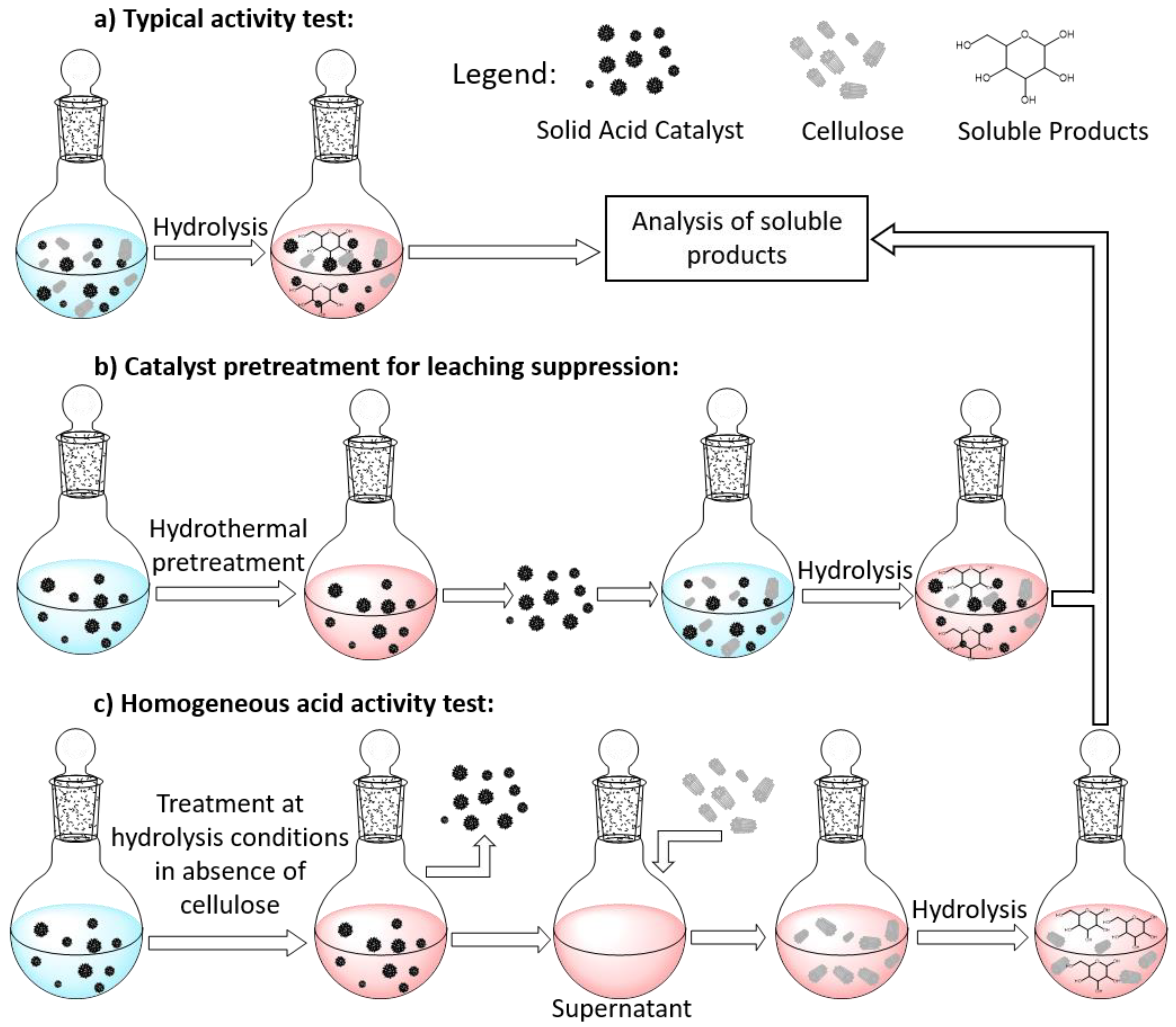
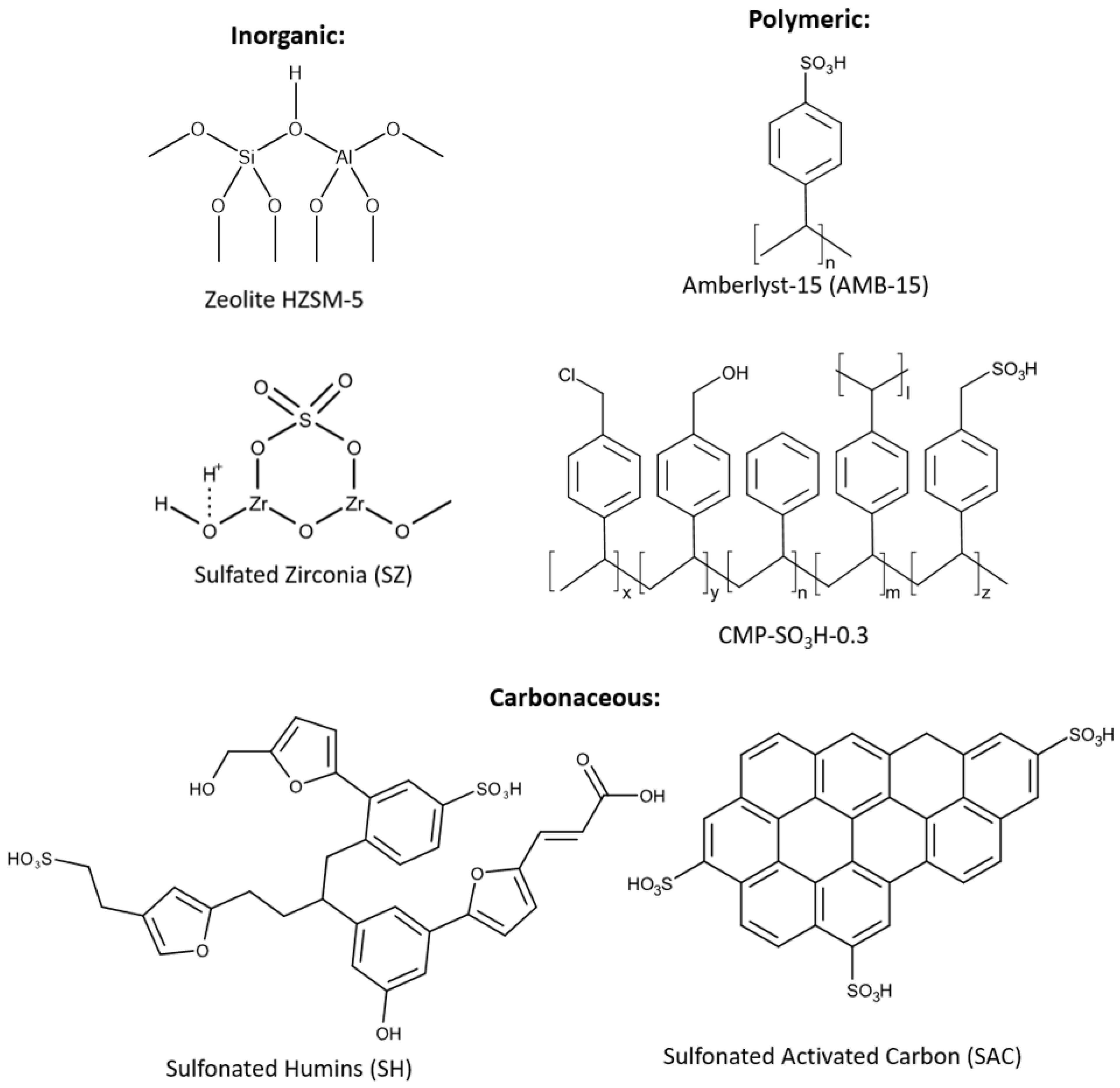
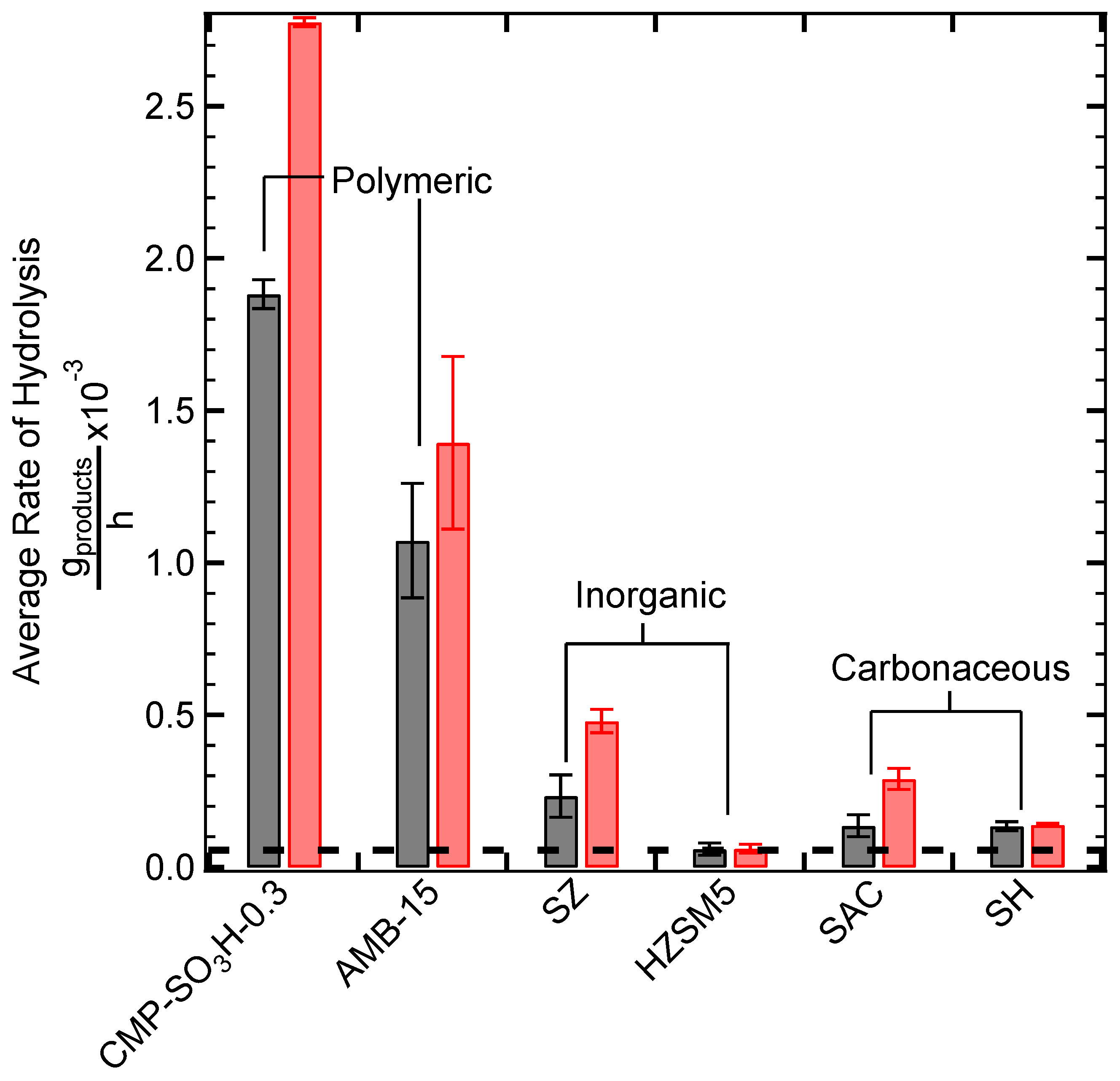
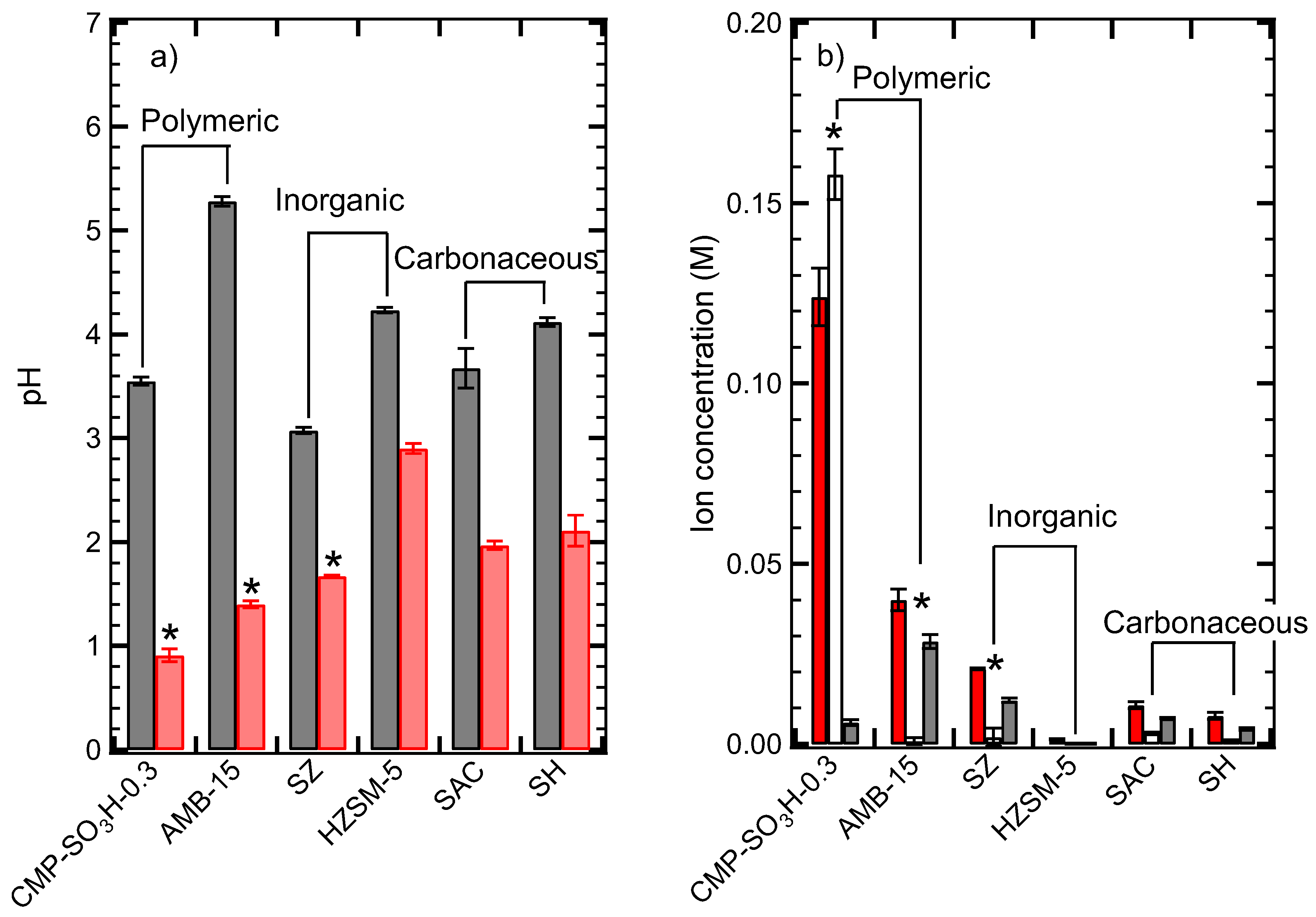


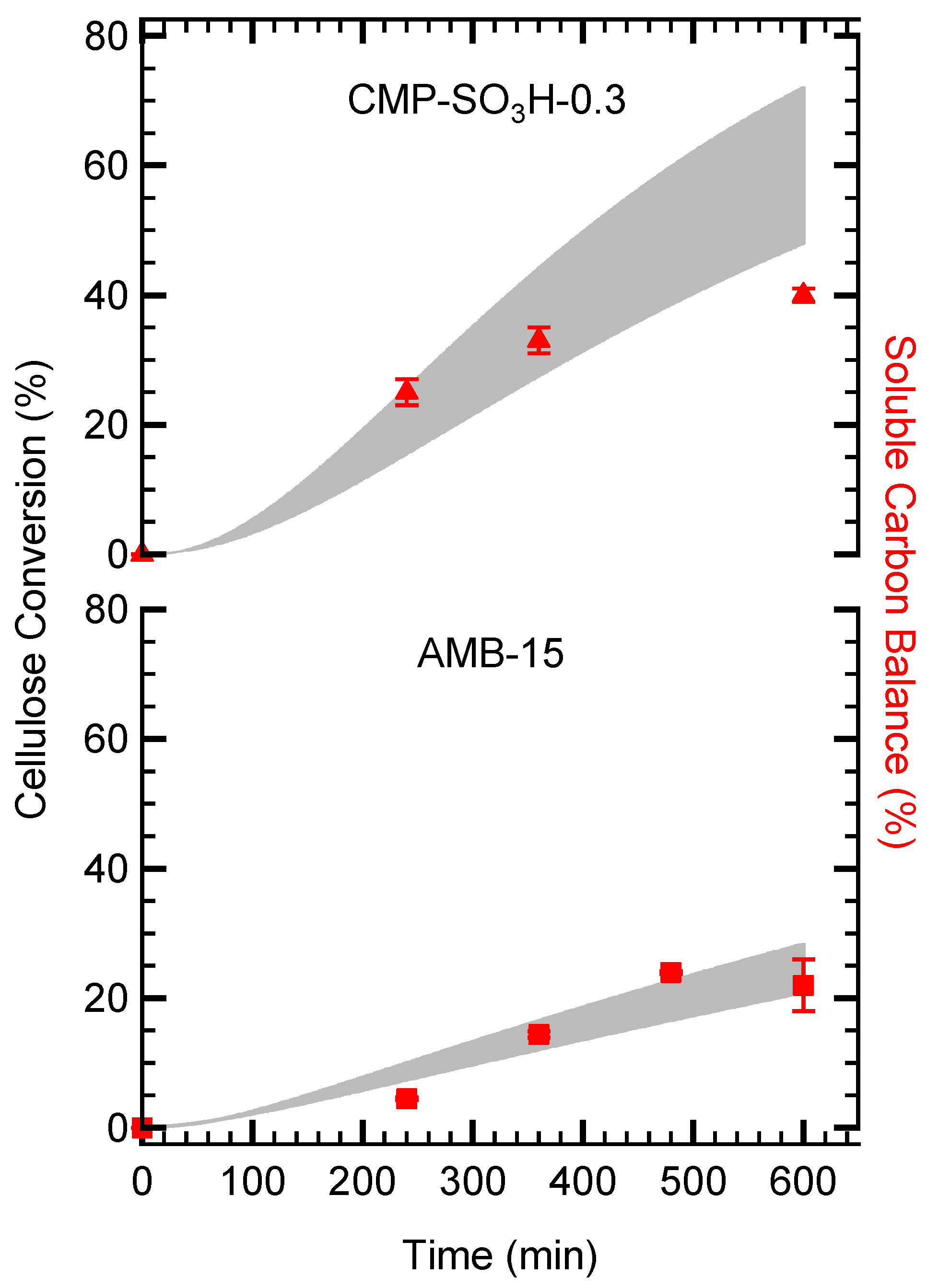
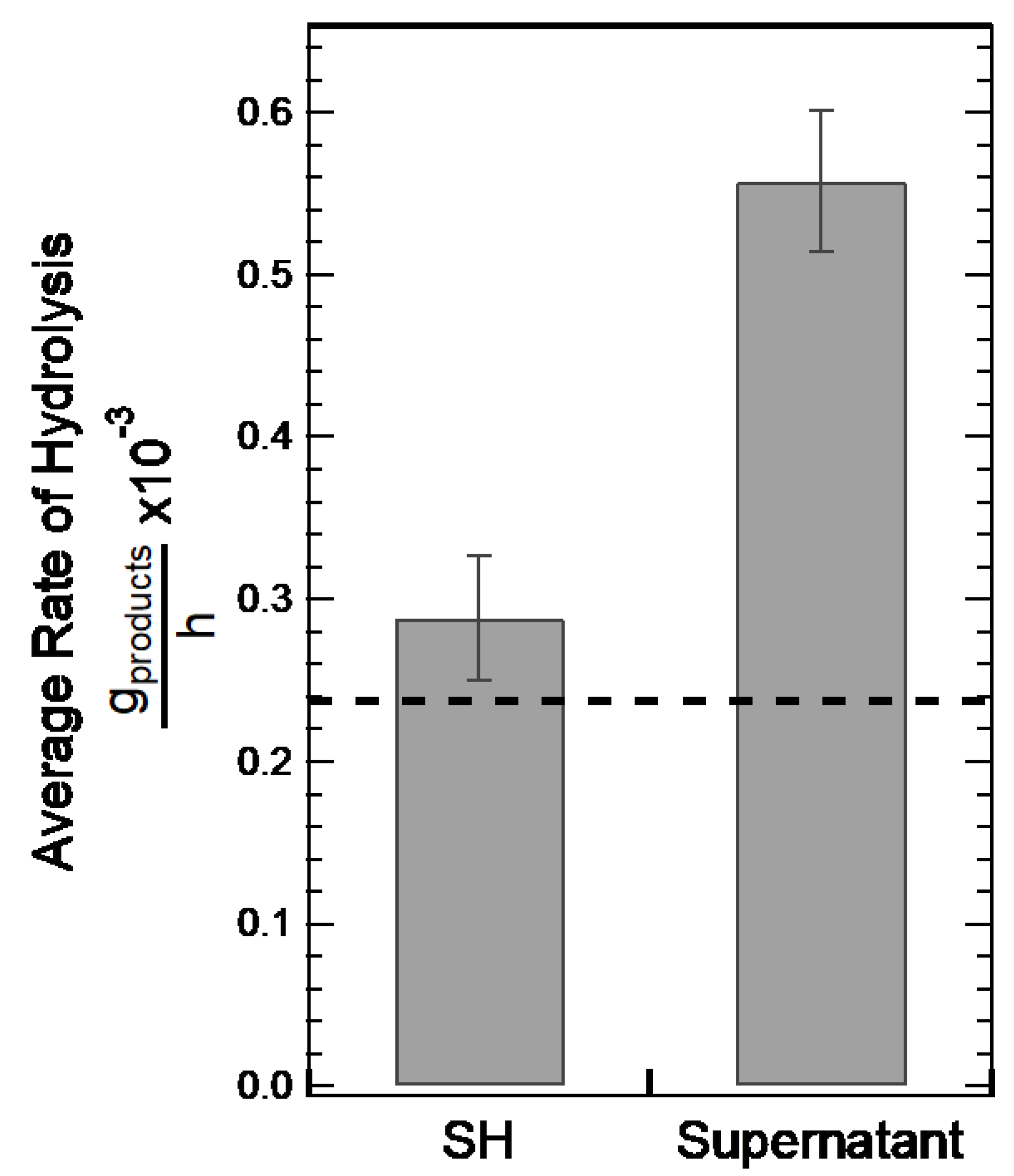
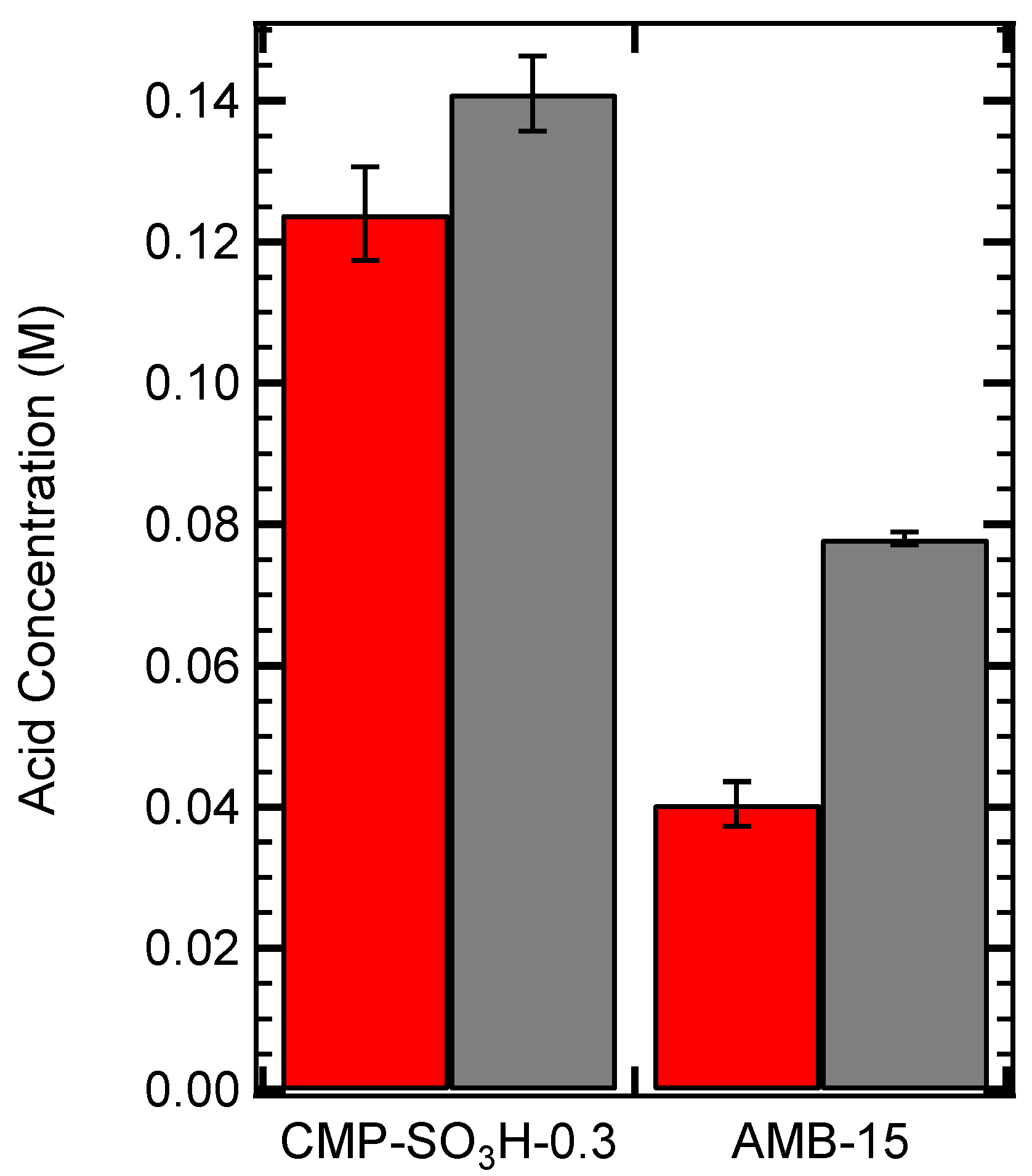

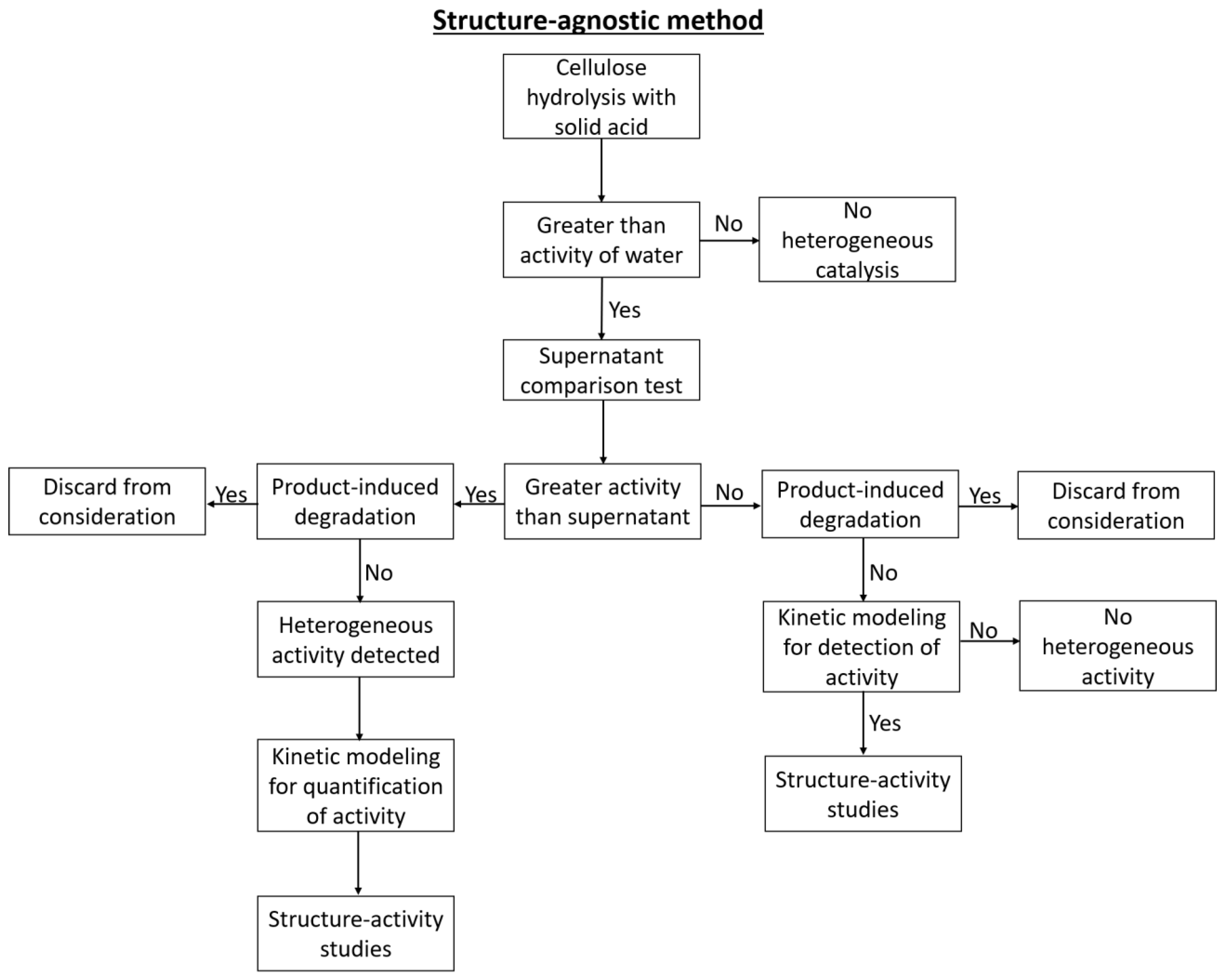
Publisher’s Note: MDPI stays neutral with regard to jurisdictional claims in published maps and institutional affiliations. |
© 2021 by the authors. Licensee MDPI, Basel, Switzerland. This article is an open access article distributed under the terms and conditions of the Creative Commons Attribution (CC BY) license (https://creativecommons.org/licenses/by/4.0/).
Share and Cite
Tyufekchiev, M.; Finzel, J.; Zhang, Z.; Yao, W.; Sontgerath, S.; Skangos, C.; Duan, P.; Schmidt-Rohr, K.; Timko, M.T. A New Method for Solid Acid Catalyst Evaluation for Cellulose Hydrolysis. Sustain. Chem. 2021, 2, 645-669. https://doi.org/10.3390/suschem2040036
Tyufekchiev M, Finzel J, Zhang Z, Yao W, Sontgerath S, Skangos C, Duan P, Schmidt-Rohr K, Timko MT. A New Method for Solid Acid Catalyst Evaluation for Cellulose Hydrolysis. Sustainable Chemistry. 2021; 2(4):645-669. https://doi.org/10.3390/suschem2040036
Chicago/Turabian StyleTyufekchiev, Maksim, Jordan Finzel, Ziyang Zhang, Wenwen Yao, Stephanie Sontgerath, Christopher Skangos, Pu Duan, Klaus Schmidt-Rohr, and Michael T. Timko. 2021. "A New Method for Solid Acid Catalyst Evaluation for Cellulose Hydrolysis" Sustainable Chemistry 2, no. 4: 645-669. https://doi.org/10.3390/suschem2040036
APA StyleTyufekchiev, M., Finzel, J., Zhang, Z., Yao, W., Sontgerath, S., Skangos, C., Duan, P., Schmidt-Rohr, K., & Timko, M. T. (2021). A New Method for Solid Acid Catalyst Evaluation for Cellulose Hydrolysis. Sustainable Chemistry, 2(4), 645-669. https://doi.org/10.3390/suschem2040036






